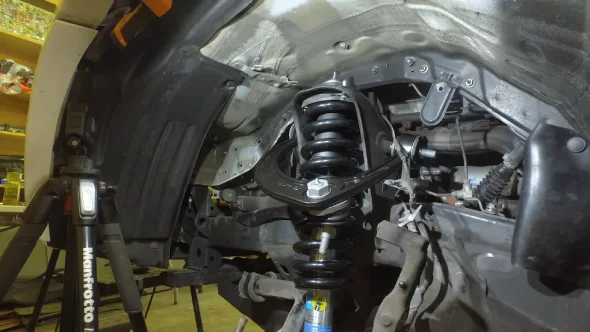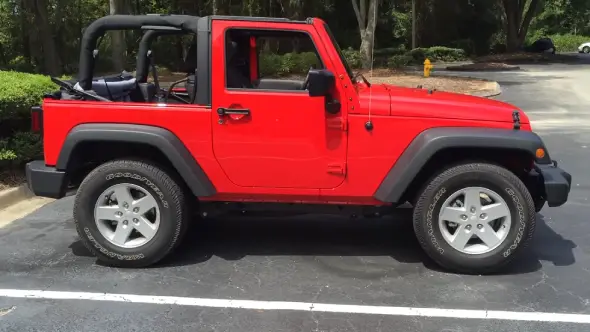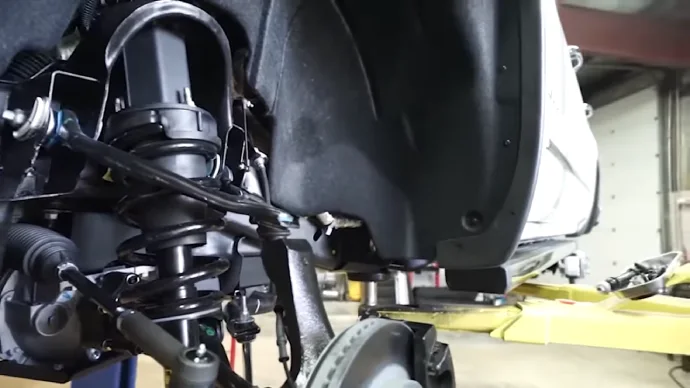Last Updated on March 19, 2023
Is your car begging for an upgrade? Pushing it to the next level by stacking multiple lift kits may seem like a great idea, but we have some news: don’t do it. Adding more than one kit won’t get you higher performance, just trouble.
You can turn heads on the highway with a lift kit but beware of stacking two lift kits together. From reduced stability and poor handling issues all the way down to brake problems. There’s plenty you should consider before making such an important decision.
Read on for more information and discover why a double dose of modification just might be too much.
Why Is It Bad Having Two Lift Kits?

For an extra edge of style and performance, two lift kits on your vehicle might seem like the perfect solution. However, be mindful, as failing to install them correctly can put you in a dangerous situation.
Here are some risks with stacking two lift kits:
Reduced Stability
With two body lift kits installed, the stability of your vehicle will be greatly reduced due to the extra height it has been lifted. Due to this, the vehicle won’t be as stable or steady when cornering or traveling over uneven terrain because the center of gravity will be higher.
The added height also increases the risk of rolling over if you take a sharp turn at high speeds, leading to dangerous situations that can have serious consequences.
Poor Handling
Installing two lift kits also affects how well a vehicle handles on the road. The imbalance created by two different sizes or types of body lift kits will create excessive body roll when turning or cornering and can cause loss of control during sudden maneuvers or changes in direction.
With just one kit installed, drivers will have less control over their vehicles than expected.
Increased Wear and Tear
When you drive with two lift kits, you’re putting extra stress on your brakes and suspension, which are already engineered for a certain ride height. This will cause increased wear and tear, which could result in costly repairs down the line if left unchecked for too long.
Braking Problems
Because of their altered center of gravity and higher mass, double lift kits tend to have longer stopping distances than other vehicles without them. This means they may fail safety tests set by governing bodies such as MOTs and state DMVs.
Since they require a certain level of performance from all vehicles operating within their jurisdiction before being allowed road access.
Strain on Drivetrain
Also, installing two lift kits raises engine RPMs drastically since it requires more power output from your engine. Accelerating from a standstill or climbing hills due to its higher weight and taller stance affects its power-to-weight ratio negatively.
This can put extra strain on the drivetrain causing premature wear or even failure if not properly cared for through regular maintenance checks and inspections.
Legal Issues
It’s important to note that using multiple modifications is generally against most state laws since it increases your chances of causing an accident due to instability. As well as making your truck non-compliant with federal safety regulations like DOT (Department Of Transportation).
As a result, you might get fined for having too many modifications without proper documentation.
Why Do People Add More Than One Lift to Their Vehicle?

Maximum ground clearance and robust off-roading capabilities are must-haves for those who love pushing their vehicle to the limits. That’s why more and more people are adding multiple body lift kits to their vehicles, including:
Need More Ground Clearance
Often, people add two lift kits to their vehicle when they need more ground clearance. Two lifts are usually the easiest way to achieve this, as it helps raise the center of gravity and increase stability over rough terrain.
With a higher center of gravity, the truck can travel through obstacles with greater ease and less risk of damage. It’s also easier to maneuver around deep mud, rocks, and other terrain features with increased ground clearance.
To Get More Visibility
Adding a two-piece body lift to the vehicle is also beneficial when drivers want more visibility. The extra lift height makes it easier to see over traffic, helping drivers spot potential hazards quicker and giving them a better view of the road ahead.
As drivers navigate hazardous conditions like snow, mud and sand from a higher vantage point, they will be able to make better decisions.
For Appearance Improvement
Many people choose to add a two-piece lift kit to their vehicle simply because they like the way it looks. The additional height gives cars an aggressive stance that many enthusiasts find attractive.
Also, it makes it easier for vehicles with large tires to fit beneath fenders and wheel wells without rubbing against each other.
Getting Better Approach and Departure Angles
When tackling off-road trails or steep hillsides, multiple lifts give people better approach and departure angles. The added suspension lift kit raises the center of gravity.
Without insufficient clearance underneath the frame, the car can easily climb onto ledges or over large rocks without getting stuck. This can drastically reduce the chances of damaging either the driver or the truck when off-roading.
To Enhance Suspension Performance
Adding multiple lift kits to the vehicle isn’t just about getting increased ground clearance. A performance benefit is also found with this kind of modification.
Extended suspensions improve traction and reduce drivetrain strain through enhanced articulation and reduced drivetrain strain. These benefits can make all the difference when driving in challenging conditions.
Multiple Lift Kit Installation Mistakes People Make: What Are They?

Installing a lift kit may seem intimidating, but it can be done with the right research and preparation. Still, there are numerous common mistakes that people tend to make during this process, unfortunately leading them to costly repairs or worse.
Here’s what people do wrong when installing two lift kits:
Not Checking for Compatibility: One of the most common mistakes people make during suspension lift kit installation is not checking for compatibility between the parts. Before you begin any installation process, it’s important to ensure that all parts will fit together properly and will be able to support the weight of your vehicle.
Choosing the Wrong Kit: You must choose a lift kit specifically designed for your vehicle’s model and year. Generic body lift kits can damage other components and cause avoidable damage or, worse, accidents. Whenever possible, it’s best to go with a good quality manufacturer-approved lift kit.
Not Testing the Suspension: If you’re installing a suspension system such as shocks or springs for a lifted vehicle, you must test them thoroughly before taking your car out on the road. Taking time to road-test your setup is key for any kind of installation, no matter how confident you feel about it.
Not Upgrading Other Components: Another common mistake when installing a suspension lift kit is not upgrading other components to keep everything in balance and working together. Invest in wheel spacers, axle housings, aluminum driveshafts, bigger tires, etc., if you’re lifting your truck more than two inches.
Improper Torque Settings: Tighten all suspension bolts properly to avoid rattling or wobbling at higher speeds on uneven surfaces like gravel roads or dirt tracks. Double-check torque settings after you adjust/install suspension with torque wrenches to make sure you and others are safe.
Neglecting Alignment: Setting camber & toe after adjusting ride heights by means of either Coilover install (static) or airbag install (active) systems should never be neglected. Not just larger tire wear but steering control, feedback, and overall road handling are all affected by wheel alignment.
Overlooking Suspension Geometry: Every component used within a multi-link suspension setup has its purpose. Hence, overlooking even minute details (such as ineffective spring rates compared to OEM ones) can have unexpected results.
Therefore, double-check the results if you modify/adjust anything related to several linkages connecting the chassis frame & axles.
Do Multiple Lift Kits Affect a Car’s Towing And Hauling Abilities?

Multiple leveling kits do not have an effect on a vehicle’s towing or hauling abilities. This is because the body lift kit only changes the vehicle’s center of gravity and does not affect the mechanical components that enable towing or hauling.
While mounting larger wheels and tires can increase traction and improve overall handling, they will not directly impact a car’s capabilities in terms of towing or hauling. It should be noted that adding multiple lift kits may increase your tire size and ground clearance.
Doing so could eventually lead to suspension problems if too much weight is added to your vehicle. Therefore, when determining how many lift kits your truck needs, you must weigh any additional modifications you make and how they will affect its performance.
Can Installing Two Lift Kits Affect the Resale Value of a Vehicle?
Installing two lift kits can have both a positive and negative effect on a vehicle’s resale value. A well-installed leveling kit can add to a vehicle’s appearance and performance, making it more attractive to potential buyers.
However, if the lift kits are not installed properly or are too large for the vehicle, there may be problems with stability and handling that could affect its resale value. Also, since lift kits alter the factory settings of a truck, some buyers may be wary of buying a modified vehicle due to concerns over reliability and safety.
Enhance Your Ride with Lift Kits: Consider the Pros and Cons
When equipped with multiple lift kits, your truck or car can look bold and commanding but beware of the potential costs. Too much of a good thing could lead to reduced stability, poor handling, increased wear & tear on parts, braking problems or even drivetrain strain.
All of these things should be considered before deciding whether or not adding multiple lifts is worth it for your vehicle. Consultation with an expert is strongly recommended. They can provide invaluable advice regarding choosing the right parts to install or maintain lifts.
